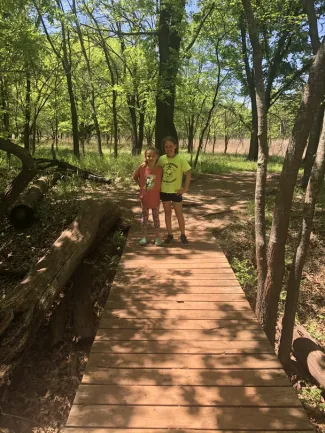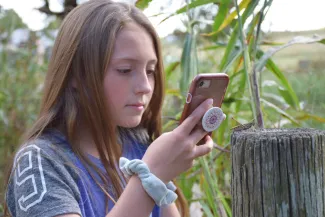This article about sharing nature sightings was first published in the March/April 2021 issue of the Wildlife Department's bimonthly magazine, "Outdoor Oklahoma." Subscribe to our magazine through Go Outdoors Oklahoma.
Having the opportunity to enjoy the outdoors is something I treasure. Whether hunting, fishing or simply going on a hike, taking in all that nature has to offer is among my favorite pastimes. What’s even better than being outdoors is instilling in my children an appreciation for time and space outside.
I realized when they were very young that my girls Cheyenne, 12, and Audrey, 9, truly loved being in nature. Any opportunity we get to be outside, we take it, even if it’s just a quick picnic for lunch. Being outdoors is our time to slow down in this busy life and take it all in.

Audrey and Cheyenne find happiness in nature and are always ready for their next outing.
One thing I realized when I moved from a rural area to a city was that you didn’t have to travel far to just get outside and explore. You just have to look a little bit harder and maybe in some different places to find whatever you are looking for.
In a rural area, it’s easy to walk out your back door and go for a hike and experience wildlife and everything nature has to offer. But if you’re in the middle of a city, you may have to get creative. My girls were going to explore, and it didn’t matter where we were. I just had to keep up! They were going to make the best of it and capture everything along the way. And you can, too! Get outside and explore, you never know what you might find!
It wasn’t long before my oldest daughter, Cheyenne, was asking for my smartphone while we were out exploring. She was always taking pictures with my phone’s camera. Later she would proudly show me the pictures she took, reminiscing of what she experienced while in the outdoors.

Cheyenne lines up the shot on a friendly insect. Photos and details of nature sightings can be shared on many nature apps.
It also didn’t take long for me to notice that they were actually good photos she was taking. She not only had an eye for a great shot, but she was constantly looking for the next critter or flower to capture with the camera. Being outdoors became more than just running outside.
“Where is the next animal track going to be? If we are quiet, we might see some wildlife. What kind of flower is that, Mom?” These are things my girls would say to me. This also kept me on my toes.
Little sister, Audrey, would be right on Cheyenne’s heels exploring. Audrey’s favorite book became one about animal tracks that we had found in an old bookstore. This book helped feed both girls’ curiosity and engagement.
After an outdoor adventure, we will sit and discuss what we saw. We will scroll through the pictures Cheyenne took, and many questions would arise. But many of those questions that seemed simple were questions for which I didn’t have the answers. So, I explored ways to keep Cheyenne engaged.
I discovered iNaturalist.org. One of the world’s most popular nature apps, iNaturalist helps users identify the plants and animals around them. Cheyenne already enjoyed recording her findings in the outdoors. Now she could share them in an online social network of people sharing biodiversity (the variety of life in the world or in a particular habitat or ecosystem) with information to help each other learn more about nature.
Cheyenne began contributing to iNaturalist. While we were exploring and spending quality time together, she was learning about her surroundings and sharing those findings with others. Her photos became more than just photos; now they were observations that documented living things at a specific place and time. She was also helping others, as her observations were shared globally with a community of naturalists who could identify and discuss these species. Cheyenne was contributing to science!
Just imagine the excitement from this little girl’s view. She wasn’t just sharing her explorations with Mom from the hike they went on. She was sharing around the world and getting feedback! She was becoming a naturalist and making observations. She could now become a citizen scientist or join in on a BioBlitz survey!
The iNaturalist app made it easy to keep Cheyenne engaged and learning about something she was already doing. Plus, she had answers to her questions. It’s simple to use, too. We just downloaded the iNaturalist app. Once logged in, she could start sharing her observations and getting feedback right away.

Frogs are fair game in iNaturalist submissions.
Spending quality time together as a family is something I strive for as a mother. Being present and engaging with my children in this modern world can be a challenge. To think of using an app and a smartphone to get more connected with nature and with my kids doesn’t seem obvious. But combining the two worlds of technology and nature has created a bridge that is expanding our knowledge of the outdoors and our time together in it. We look forward to our next adventure.
So, get your loved ones outside and see what observations you can find. You might just be surprised by your surroundings and excited by the biodiversity you can find.
Connecting People, Nature is iNaturalist’s Primary Goal
One of the world’s most popular nature apps, iNaturalist helps you identify the plants and animals you find. More than 1 million scientists and naturalists are connected to help you learn more about nature. By recording and sharing your observations, you’ll create research-quality data for scientists working to better understand and conserve nature.
At its core, iNaturalist is an online social network for sharing biodiversity information to help others learn about nature. It’s also a crowdsourced species identification system and an organism occurrence recording tool. You can use it to record your own observations, get help with identifications, collaborate with others to collect this kind of information for a common purpose, or access the observational data collected by iNaturalist users.
Even though it might seem very scientific, the primary goal of iNaturalist is to connect people to nature, getting them to feel that the non-human world has personal significance and is worth protecting.
The app’s secondary goal is to generate scientifically valuable biodiversity data users’ natural encounters. The operators of iNat believe they can achieve both of those goals simultaneously and that they reinforce one another.
The iNaturalist.org website began as a Master’s final project by Nate Agrin, Jessica Kline, and Ken-ichi Ueda at University of California-Berkeley’s School of Information in 2008. Nate and Ken-ichi continued working on the website after graduation, with some additional help from Sean McGregor. Ken-ichi began collaborating with Scott Loarie in 2011, when they organized as iNaturalist LLC and began expanding the site through numerous collaborations. In 2014, iNaturalist became an initiative of the California Academy of Sciences and a joint initiative with National Geographic Society in 2017.